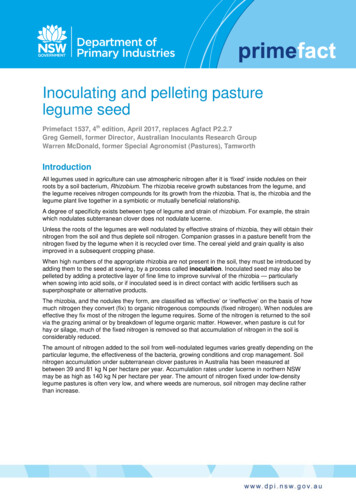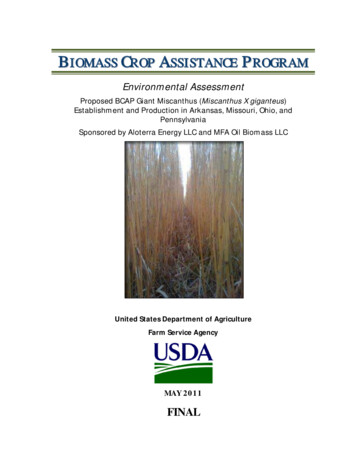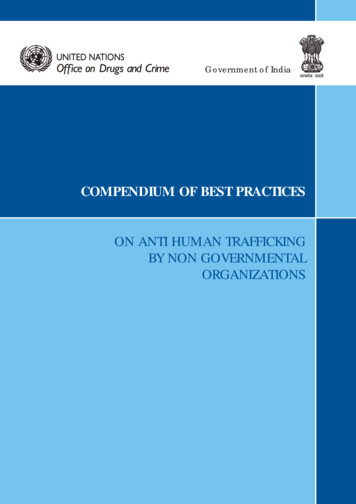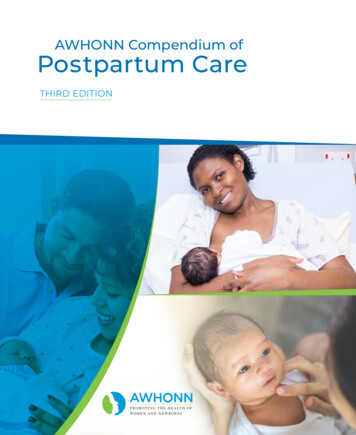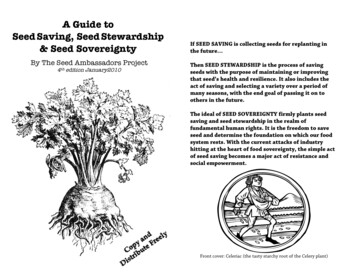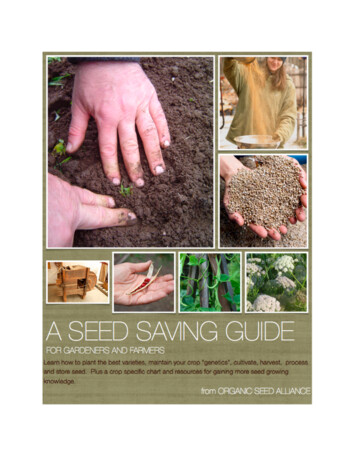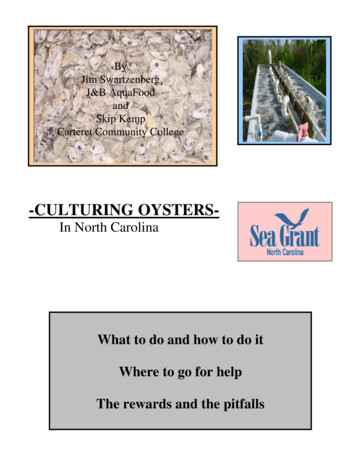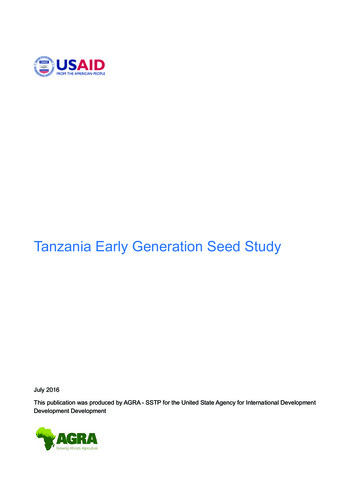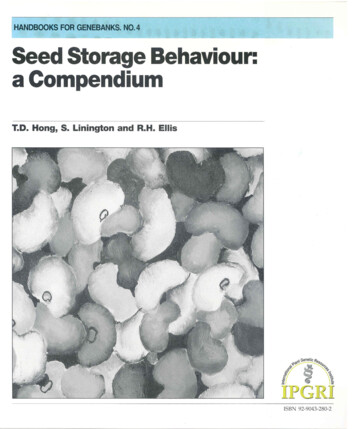
Transcription
SEED STORAGE BEHAVIOUR: A COMPENDIUMiHandbooks for Genebanks: No. 4Seed Storage Behaviour: a CompendiumT.D. Hong1, S. Linington2 and R.H. Ellis11Department of Agriculture, The University of Reading, Earley Gate, P.O. Box 236,Reading RG6 6AT, UK2Royal Botanic Gardens Kew, Wakehurst Place, Ardingly, Haywards Heath, WestSussex, RH17 6TN, UKInternational Plant Genetic Resources Institute
iiHANDBOOKS FOR GENEBANKS NO. 4The International Plant Genetic Resources Institute (IPGRI) is an autonomousinternational scientific organization operating under the aegis of the ConsultativeGroup on International Agricultural Research (CGIAR). The international status ofIPGRI is conferred under an Establishment Agreement which, by December 1995,had been signed by the Governments of Australia, Belgium, Benin, Bolivia, BurkinaFaso, Cameroon, China, Chile, Congo, Costa Rica, Côte d’Ivoire, Cyprus, CzechRepublic, Denmark, Ecuador, Egypt, Greece, Guinea, Hungary, India, Iran, Israel,Italy, Jordan, Kenya, Mauritania, Morocco, Pakistan, Panama, Peru, Poland,Portugal, Romania, Russia, Senegal, Slovak Republic, Sudan, Switzerland, Syria,Tunisia, Turkey, Ukraine and Uganda. IPGRI's mandate is to advance theconservation and use of plant genetic resources for the benefit of present and futuregenerations. IPGRI works in partnership with other organizations, undertakingresearch, training and the provision of scientific and technical advice andinformation, and has a particularly strong programme link with the Food andAgriculture Organization of the United Nations. Financial support for the agreedresearch agenda of IPGRI is provided by the Governments of Australia, Austria,Belgium, Canada, China, Denmark, France, Germany, India, Italy, Japan, theRepublic of Korea, Mexico, the Netherlands, Norway, Spain, Sweden, Switzerland,the UK and the USA, and by the Asian Development Bank, IDRC, UNDP and theWorld Bank.The geographical designations employed and the presentation of material inthis publication do not imply the expression of any opinion whatsoever on the partof IPGRI or the CGIAR concerning the legal status of any country, territory, city orarea or its authorities, or concerning the delimitation of its frontiers or boundaries.Similarly, the views expressed are those of the authors and do not necessarily reflectthe views of these participating organizations.Citation:Hong, T.D., S. Linington and R.H. Ellis. 1996. Seed Storage Behaviour: aCompendium. Handbooks for Genebanks: No. 4. International Plant GeneticResources Institute, Rome.Cover illustration by Maddine InsalacoISBN 92-9043-280-2IPGRIVia delle Sette Chiese, 14200145 RomeItaly International Plant Genetic Resources Institute, 1996
SEED STORAGE BEHAVIOUR: A COMPENDIUMiiiContentsPrefaceivGlossary of TermsviAcronyms and AbbreviationsixPart IA. An Introduction to Seed Storage Behaviour11. Introduction22. Classification of seed storage behaviour33. Characteristics of orthodox seeds74. Characteristics of recalcitrant seeds175. Characteristics of intermediate seeds216. Factors leading to the misinterpretation of seed storage behaviour247. Approaches to predict seed storage behaviour28Part IB. Information on Seed Storage BehaviourIntroductionAppendix I. Viability Constants383943Appendix II. List of plant families in this Compendium and the numberof species in the different categories of seed storage behaviour49Literature CitedPart II. CompendiumNote to the reader:The information contained in the Compendium is now available through theonline searchable database 'IPGRI Species Compendium' on IPGRI's web site eciescompendium58
ivHANDBOOKS FOR GENEBANKS NO. 4PrefaceThis handbook provides an introduction to seed storage physiology for thoseresponsible for plant genetic conservation and a selective summary of the literatureon seed survival in storage, and thus on seed storage behaviour, for over 7000species from 251 families.Part IA summarizes progress in our understanding of seed physiology inrelation to seed storage for genetic conservation in the past 17 years since thepublication of The Storage of Recalcitrant Seeds: Achievements and Possible Approachesby King and Roberts (1979), and particularly the various problems that may resultin the misclassification of seed storage behaviour.Part IB provides a compendium of information on seed survival during storageand attempts to classify plant species into the several categories of seed storagebehaviour.Classification of seed storage behaviour is an essential step in devising asuitable method of conservation for each species. This is because long-term seedstorage for genetic conservation under the conditions recommended by IPGRI(formerly IBPGR) is possible for species which show ‘orthodox’ seed storagebehaviour. Medium-term storage under well-defined storage conditions is possiblefor species which show ‘intermediate’ seed storage behaviour. Such storageunderwrites in situ conservation activities against the threats of epidemics, fire,human pressures, etc. and against similar losses at field genebanks. It alsofacilitates utilization.However, for species with ‘recalcitrant’ seeds, seedconservation is inappropriate (other than as a very short-term measure) and fieldgenebanks, tissue culture techniques and/or in situ conservation will need to beadopted. Knowing where seed conservation can be applied is thus essential tothose planning conservation strategies and this handbook attempts to address thisissue. Finally, information in this volume is required by seed collectors devisingappropriate methods of handling and storing seeds over the short term.This handbook is the fourth in the series. The first handbook in this seriescovered the design of long-term seed stores for genetic conservation (Cromarty et al.1982). The second and third were concerned with approaches to germinate theseeds withdrawn from these stores (Ellis et al., 1985a, 1985b). This handbookcomplements the earlier handbooks, which made only passing reference to thesurvival of seeds in storage and to the variation in seed storage behaviour amongcontrasting species; this handbook updates (and expands considerably) parts ofthose previous handbooks.In preparing this compendium we have relied heavily on publications, seedlists, reports, handbooks and other material published in different languages frommany parts of the world. We are therefore very grateful to the staff of the Libraryof The University of Reading for their help in obtaining such publications. Manyinstitutes were contacted and we are most grateful to (in alphabetical order) Dr D.Astley (Genetic Resources Unit, Horticulture Research International, UK), Dr J.S.Brouard (Project Manager, SADC Tree Seed Centre Network, Zimbabwe),Professors D. Côme and F. Corbineau (Université Pierre et Marie Curie, Paris,France), Dr I.D. Kossmann Ferraz (Instituto Nacional de Pesquisas da Amazonia,Manaus, Brazil), Dr B. Krishnapillay (Seed Technology Centre, Malaysia), Mr O.Leveron (Escuela Nacional de Ciencias Forestales, Honduras), Mr. C. Marunda(Seed Centre, Zimbabwe), Mr L. Motoma (Forestry Association of Botswana), MrH.P. Msanga (DANIDA/ Tanzania Tree Seed Programme), Professor A.R. Nautiyal(Garhwal University, India), Dr Doai Van Nguyen (National Forest Seed Company,Vietnam), Mr W. Omondi (Kenya Forestry Seed Centre), Mr P. Pukittayacamee(ASEAN-Canada Forest Tree Seed Centre, Thailand), Dr K. Poulsen (DANIDAForest Seed Centre, Denmark), Dr G.S. Richmond (Curtin University ofTechnology, Perth, Australia), Mr I.M. Shehaghilo (Tanzania Forestry Research
SEED STORAGE BEHAVIOUR: A COMPENDIUMvInstitute), Professor G.M. Simpson (University of Saskatchewan, Canada), Mr.Enrique Trujillo N. (Banco Latinoamericano de Semillas Forestales, CATIE, CostaRica), and to Professor C. Vazquez-Yanes (Universidad Nacional Autonoma deMexico, Mexico) for providing reprints, documents, seed lists, etc.; to Professor E.H.Roberts (The University of Reading, UK), Drs H.W. Pritchard, R.J. Probert, and MrR.D. Smith (RBG Kew, Wakehurst, UK) for their many helpful comments andsuggestions, and to the following staff from the Herbarium RBG Kew, UK for theirchecking of scientific names used in certain plant families: Ms S. Bidgood(Scrophulariaceae), Dr R.K. Brummitt (certain problem genera), Dr T.A. Cope(Gramineae - general), Dr P.J. Cribb (Orchidaceae), Dr J. Dransfield (Palmae), DrI.K. Ferguson (Scrophulariaceae), Dr D.J.N. Hind (Compositae, Dipsacaceae andValerianaceae), Mr G.P. Lewis (Leguminosae), Dr A.J. Paton (Labiatae), Dr L. RicoArce (Leguminosae), Dr C. Stapleton (Gramineae - bamboos), and Mr N.P. Taylor(certain Rosaceae).
viHANDBOOKS FOR GENEBANKS NO. 4Glossary of TermsAchene. A dry indehiscent one-seeded pericarp (e.g. lettuce).Acorn. The fruit of the oak (Quercus spp.) and comprised of a nut and its cup orcupule.Aril. An appendage or an outer covering of a seed, growing out from the hilum orfuniculus; it sometimes appears as a pulpy covering.Berry. Pulpy indehiscent few- or many-seeded fruit; technically the pulpy fruitresulting from a single pistil, containing one or more seeds (e.g. tomato) but notrue stone.Calyx. The outer circle of floral envelopes, comprised of the sepals; the latter maybe distinct or connate in a single structure.Capsule. Compound pod; a dry fruit of more than one carpel, usually opening atmaturity by one or more lines of dehiscence (e.g. poppy).Caruncle. A fleshy, sometimes coloured, appendage of the outer integuments forsome seeds.Caryopsis. An achene with pericarp and seed testa inseparably fused (e.g. Gramineae)Catkin. A scaly-bract usually flexuous spike or spike-like raceme with diclinousflowers (e.g. willow).Cone. A dense and usually elongated collection of flowers or fruits that are bornebeneath scales, the whole with scales and axis forming a detachablehomogenous fruit-like body (e.g. pine).Cotyledon (s). The primary leaf (or leaves) in the embryo.Deciduous. A plant whose leaves are shed at a specific season or growth stage.Dehiscence. The method or process of opening of a seed-pod; loculicidallydehiscent when the split opens into a cavity or locule; septicidally dehiscentwhen splitting along septum of the ovary; circumscissally dehiscent when thetop valve comes off as a lid.Dormancy. The condition of a live seed which prevents germination when it issupplied with the conditions normally considered to be suitable forgermination, viz. adequate moisture, a suitable temperature and adequateaeration.Drupe. A fleshy one-seeded indehiscent fruit with seed enclosed in a stonyendocarp (stone-fruit) (e.g. Aleurites).Drupelet. One drupe in a fruit made up of aggregate drupes (e.g. raspberry).Embryo. The rudimentary plant within a seed, which arises from the zygote orsometimes from an unfertilized egg cell. It consists of an axis bearing an apicalmeristem or a plumule, a radicle, and one or more cotyledons.Endocarp. The inner layer of the pericarp.Endosperm. Triploid tissue which develops from the fusion of a sperm nucleuswith the two polar nuclei of the embryo sac. It supplies nutrients to the embryoand may be entirely used up during seed formation, or part of it may remainand sustain the seed during germination.Follicle. Dry dehiscent fruit opening only on the front suture and the product of asimple pistil (e.g. Delphinium).Germination. Ultimately the production of a seedling from a seed; the emergenceof the radicle from the seed is normally the first visible sign that germinationhas commenced, but germination begins from the first metabolic process duringimbibition.Germination test. A laboratory test to estimate the proportion of seeds within anaccession capable of germinating.Herb. Plant naturally dying to the ground, without persistent stem above ground,and lacking definite woody firm structure.Hermetic storage. Storage in an air-tight, moisture-proof container.Intermediate seed storage behaviour. A category of seed storage behaviour
SEED STORAGE BEHAVIOUR: A COMPENDIUMviiintermediate between those defined as orthodox and recalcitrant. For a detaileddefinition see Part IA, Section 5. Mature whole seeds are able to toleratedesiccation to seed moisture contents in equilibrium at 20 C with about 40-50%relative humidity but further desiccation often reduces viability and alwaysresults in more rapid deterioration in subsequent hermetic storage the more theseeds are dried below this value.Long-term storage. The storage of seed accession for long-term periods (a decadeat a minimum, but many such stores expect satisfactory storage for 50-100 yearsor more). Stores operated at subzero temperatures are generally classed aslong-term seed stores, but the storage conditions recommended by IPGRI(formerly IBPGR) for long-term seed conservation are –18 C or less in air-tightcontainers at a seed moisture content of 5 1%. (w.b.) (Cromarty et al. 1982).Longevity. Life span. In seeds, it is the length of time that they remain viable. Thelife span depends on the species and the environmental conditions under whichthe seeds are stored. The duration is often qualified by the percentage of seedviability at the end of the period because seedlots are populations in whichsome seeds die sooner than others (e.g. 85% viability in order to ensure that themajority of individuals in the seed population are viable and in good conditionat the end of this period).Medium-term storage. The storage of seed for medium-term periods as is oftenused for active collections in genebanks or by plant breeders and seedsmen.Under the same conditions of storage, the seeds of different species will havedifferent periods of longevity. Thus it is difficult to define precisely the periodenvisaged by ‘medium-term’. A period of 2-10 years or so is generallyassumed. As a guide, stores which are run at temperatures between 0 and 10 Chave been listed as medium-term stores.Nut. An indehiscent, one-seeded, hard and bony fruit, even if resulting from acompound ovary (e.g. chestnut).Nutlet. A small nut.Open storage. Storage conditions where seeds are exposed directly or indirectly toambient relative humidity (and sometimes also temperature); for example, in apaper bag, cloth bag, or a similar material which permits seed moisture contentto be influenced by ambient relative humidity.Orthodox seed storage behaviour.Mature whole seeds not only surviveconsiderable desiccation (to at least 5% moisture content) but their longevity inair-dry storage is increased in a predictable way by reduction in seed storagemoisture content and temperature (e.g. to those values employed in long-termseed stores). See Part IA, Section 3 for further information.Perianth. The collective term for the calyx and corolla. It is made up of one ormore whorls of floral leaves (petals and sepals).Pericarp. The fruit wall which has developed from the ovary wall. The pericarpcomprises the endo-, meso- and exocarps. There are various forms such as dry,fleshy and woody pericarps.Pome. A fruit in which the multiseeded core is surrounded by a papery endocarpwhich, in turn, is fused to the fleshy receptacle (e.g. apple).Preferred storage conditions. The storage conditions recommended by FAO and IPGRI(formerly IBPGR) for long-term seed conservation, viz. storage at –18 C or less inair-tight containers at a seed moisture content of 3-7% (w.b.) (Engels and Tao 1994).Pod. A dehiscent dry pericarp.Pyrene. The stone of a small drupe.Recalcitrant seed storage behaviour. Mature whole seeds are unable to toleratemore than a limited amount of desiccation, for example to moisture contents inequilibrium at 20 C with about 96-98% relative humidity or a seed waterpotential of around –1.5 to –5MPa. See Part IA, Section 4 for more information.Samara. Indehiscent winged fruit (e.g. Acer).Schizocarp. A dry dehiscent fruit that splits into two halves, each half a mericarp(e.g. Umbelliferae).
viiiHANDBOOKS FOR GENEBANKS NO. 4Shrub. A woody plant that remains low and produces shoots or trunks from the base.Siliqua. The long fruit of certain Cruciferae.Tree. A woody plant that produces one main trunk and a more or less distinct andelevated head.Utricle. A bladdery one-seeded and usually indehiscent fruit (e.g. Basella).Viability. The possession in a seed of those processes essential for a seed togerminate. Thus a viable seed is alive; but this does not ensure that the seedwill germinate (for example, if the seed is dormant). Within an accession,percentage viability is the proportion of seeds which are viable; it is estimatedfrom the result of a viability test.Viability test. A test on a sample of seeds withdrawn from the accession designedto estimate the percentage viability of the accession. A germination test canonly function as a viability test either if all the seeds are non-dormant, or ifspecial treatments are applied to remove dormancy. An alternative viabilitytest procedure which does not require special treatments to remove dormancy isthe tetrazolium test; in forest tree seed testing the term viability test is oftensynonymous with a tetrazolium test.
SEED STORAGE BEHAVIOUR: A COMPENDIUMixAcronyms and AbbreviationsAVRDCBLSFAsian Vegetable Research and Development Center, TaiwanBanco Latinoamericano de Semillas Forestales, Catalogo de SemillasForestales 1994; Centro Agronomico Tropical De Investigation yEnseñanza, Proyecto de Semillas Forestales (PROSEFOR)CIATCentro Internacional de Agricultura Tropical, Cali, ColombiaCIMMYTCentro Internacional de Mejoramiento de Maiz y Trigo, El Batan, MexicoCNSFCentre National de Semences Forestières, Ouagadougou, Burkina Faso,Catalogue 1995-1996CWCoefficient indicating the response of seed longevity to moisture content(from the viability equation). See Part IA, Section 3.2DDicotyledonsDFSCDanida Forest Seed Centre, Seed List 1993ELSMCLowest safe embryo moisture content (%, w.b.), below which viability ofexcised embryos (or embryonic axes) is reducedEMCSEmbryo moisture content (%, w.b.) at shedding, harvest, maturityESNACIFOREscuela Nacional de Ciencias Forestales, Banco de Semillas,Siguatepeque, HondurasFSB/Argentina Forest Seed Bank, Santiago del Estero, ArgentinaGGymnospermHBSTGBHandbook of Seed Technology for Genebanks. Volume II. (Ellis et al., 1985b)ICARDAInternational Center for Agricultural Research in the Dry Areas, Aleppo,SyriaICRISATInternational Crops Research Institute for the Semi-Arid Tropics,Hyderabad, IndiaIITAInternational Institute of Tropical Agriculture, Ibadan, NigeriaIPGRIInternational Plant Genetic Resources Institute, Rome, ItalyISTAInternational Seed Testing Association; ISTA (1993a, 1993b)LMCLLow-moisture-content limit (%, w.b.) to the viability equation, see PartIA, Section 3.3LSMCLowest safe moisture content, also termed “critical moisture content” (%,w.b.), below which viability is significantly reduced by further desiccationMMonocotyledonsmcMoisture content (%, w.b.)MCSWhole seed moisture content (%, w.b.) determined at shedding, harvest,maturityNSSLNational Seed Storage Laboratory, Fort Collins, USAOrthodox pOrthodox probable. See Part IB, Introductionpers. comm.Personal communicationp50Half-viability period, i.e., time taken for 50% of the seeds to lose viabilityPGRC/Ethiopia Plant Genetic Resources Centre, EthiopiaRGB Kew, WP Seed Bank, Royal Botanic Gardens Kew, Wakehurst Place, UKr.h.Relative humidityRSSRecommended seed storage conditionsSSLRResults of unpublished research, Seed Science Laboratory, Departmentof Agriculture, The University of ReadingTSWThousand-seed weight (g) (because information is collated from manydifferent sources, TSW will have been determined at different seedmoisture contents)ULMCUpper moisture content limit (%, w.b.) to the viability equation. See PartIA, Section 3.3VGBVegetable Genebank, Wellesbourne, UKw.b.Wet weight basis or fresh weight basis, when referring to seed moisturecontent*Before species name taxonomic difficulty with species listed.
xHANDBOOKS FOR GENEBANKS NO. 4
SEED STORAGE BEHAVIOUR: A COMPENDIUMPart IA. An Introduction to Seed Storage Behaviour1
2HANDBOOKS FOR GENEBANKS NO. 41. IntroductionConservation of plant genetic resources comprises two types of approach; in situand ex situ conservation. In situ conservation has been defined as the conservationof whole ecosystems and natural habitats where wild or cultivated species aremaintained and may continue to evolve. Ex situ conservation maintains germplasmoutside its original habitats, in the form of whole plants in botanical gardens andfield genebanks, seeds as in seed genebanks, or certain other parts of the plant suchas roots, dormant buds, pollen, explants as in vitro genebanks, or possibly as DNA.Knowledge of the seed storage behaviour of a target species is required in order todetermine whether or not seed storage is suitable as a method of geneticconservation, and how to handle seeds during collection and germplasm exchange.If it is feasible, long-term seed storage is generally considered the safest, mostinexpensive and most convenient method of genetic conservation. Most plantgenetic resources are conserved by this means.The importance of seed storage has been recognized ever since humans beganto domesticate plants. The duration of storage depends upon the objectives of theparticular conservation effort and the species concerned. Farmers need to maintainviable seeds from one growing season to the next while seed producers may alsowish to maintain ‘carry-over stock’ for several years. In contrast, the goal ofgenebanks is essentially the maintenance of seed viability in a very wide range ofspecies for indefinite but considerable periods, a much harder task which requiresboth specific facilities and information.This Compendium of Information on Seed Storage Behaviour should be readin conjunction with the earlier IBPGR Handbooks for Genebanks which cover thedesign and construction of long-term seed stores (Cromarty et al., 1982) and thegermination and dormancy of seed accessions (Ellis et al., 1985a), (Ellis et al., 1985b).In particular, readers are referred to Appendix 3 of Cromarty et al. (Cromarty et al.,1982) for information on seed moisture content, relations between seed moisturecontent and relative humidity, and the effect of temperature and seed compositionon these relations. Throughout this document, seed moisture content is expressedon the fresh weight basis (also described as wet basis, and often abbreviated tow.b.).
SEED STORAGE BEHAVIOUR: A COMPENDIUM32. Classification of seed storage behaviourClassification of the variation in seed storage behaviour among species is requiredbefore choosing appropriate methods of storage. Seed survival in storage has longfascinated humans. The first publication referring to seed storage behaviourappeared in 535 AD in China; Ssu-Hsieh Chia published a handbook in which herecognized two methods of seed storage. For example, for cereals he advised “notto store in warm and damp environments”, whereas with (chinese) chestnut “thefresh seeds should be stored in damp soil placed in the house, and during transportthe seeds should be packed in a leather bag, because chestnut seeds will die whenexposed to sun and wind” (Ssu-Hsieh Chia, 535). Thus it was recognized one and ahalf millenia ago that seeds of different species showed two contrasting types ofseed storage behaviour.Ewart (Ewart, 1908) divided seeds into three biological classes according to theirlife span under ordinary storage conditions:? microbiotic, i.e. seeds with life spans not exceeding 3 years;? mesobiotic, i.e. seeds with life spans from 3 to 15 years;? macrobiotic, i.e. seeds with life spans from 15 to 100 or more years.In this classification, the effect of the seed storage environment was not takeninto account.Elliott 1912, cited by (Baldwin, 1942) similarly divided (forest tree) seeds intothree classes but his classification was based on the response of seeds to desiccation:? those which can withstand drying, such as most conifers and birch (Betulaspp.);? those which can survive partial drying, such as Fraxinus spp., Tiliaamericana;? those which can rarely be dried at all, such as Quercus spp. and Fagus spp.In addition to Elliott’s classes of seed storage behaviour, Tillotson (Tillotson,1921), cited by (Baldwin, 1942) added a fourth class of species whose seeds cannotbe stored at all, such as Acer saccharinum, red maple (Acer rubrum), poplars (Populusspp.), willows (Salix spp.), elms (Ulmus spp.) and hornbeams (Carpinus spp.).Although Ewart's system of classification has been well cited, Elliott's classificationhas unfortunately been largely ignored.Forest tree seed nurseries are concerned with short-term storage and thepretreatment of seeds before or after storage. For these activities, Holmes andBuszewicz (Holmes & Buszewicz, 1958) divided temperate tree species into fivegroups:? seeds with short life spans under ordinary storage conditions (open storageat ambient temperature), but whose longevity can be improvedconsiderably by lowering seed moisture content and storage temperature(e.g. Salix, Populus, Ulmus, Betula, Alnus – note the contrast with Tillotson'scomments above);? seeds which can be stored moist for short periods or dry for long periods(e.g. Acer, Carpinus, Crataegus, Euonymus, Fraxinus, Liriodendron, Nothofagus,Prunus, Pyrus, Sorbus and Tilia);? large desiccation-sensitive seeds requiring moist storage (e.g. Aesculus,Castanea, Carya, Corylus, Fagus, Juglans and Quercus);? species which show hard impermeable seed coats and have long life spansin open storage (e.g. Leguminosae);? species whose seeds tolerate desiccation to low moisture content and can bestored hermetically at cool, near-zero or subzero temperatures (e.g.conifers).However, it will be shown in the next paragraph that, in fact, these five groupscan be represented by just two categories of seed storage behaviour.Roberts (Roberts, 1973) introduced a classification based not on longevity per se,
4HANDBOOKS FOR GENEBANKS NO. 4but on contrasting physiological responses of seed survival during storage tomoisture content and temperature. He introduced the terms “orthodox” and“recalcitrant” for the two categories of seed storage behaviour he identified.According to Roberts (Roberts, 1973), orthodox seeds can be dried to low moisturecontents (2-5%) without damage. In addition, their longevity increases withdecreases in seed storage moisture content and temperature in a quantifiable andpredictable way over a wide range of storage environments. In contrast,recalcitrant seeds cannot survive desiccation below a comparatively high (between12 and 31%) moisture content (Roberts, 1973).Roberts’ terminology has been widely adopted, and there has since been aconsiderable emphasis on research activities on recalcitrant seed physiology overthe last decade or so. Alternatives to Roberts’ terminology have been suggestedfrom time to time. For example, it has been argued that the term “poikilohydric”should replace “orthodox” to describe seeds that can be maintained in equilibriumwith ambient relative humidity for long periods, and that “homoiohydric” shouldreplace “recalcitrant” to describe those that do not tolerate desiccation (Berjak et al.,1990a) (Berjak et al., 1990b). It has also been suggested that species with recalcitrantseeds can be further categorized into three subgroups – minimally, moderately andhighly recalcitrant (Farrant et al., 1988). Minimally recalcitrant seeds can withstanddesiccation to relatively low levels of moisture content, at which germination isslow; they are also able to tolerate cooler storage temperatures, e.g. Quercus spp.,Auracaria hunsteinii and Podocarpus henkelii. In contrast, highly recalcitrant seeds areextremely sensitive to desiccation and cool temperatures, e.g. Syzygium spp. andAvicennia marina. Moderately recalcitrant seeds show a level of desiccationsensitivity between those of the above two groups, e.g. Theobroma cacao and Heveabrasiliensis (Farrant et al., 1988). Although these authors divided recalcitrant seedstorage behaviour into three subgroups, they suggested that the categories are notdiscrete. Rather, they suggested that there is a continuum of recalcitrant seed types,varying from less recalcitrant to highly recalcitrant, depending on the naturalhabitat to which they are adapted; the highly recalcitrant species tending to beadapted to tropical regions and wetlands, the moderately recalcitrant species totropical regions, and the minimally recalcitrant species to temperate or subtropicalregions (Farrant et al., 1988). Thus, this classification provides four groups(orthodox, minimally recalcitrant, moderately recalcitrant and highly recalcitrant)which take into account both the effects of storage environment and adaptation tonatural habitats.Bonner (Bonner, 1990) also suggested a classification based on storageconditions and adaptation to natural habitats. He divided tree species into fourclasses; the two main categories of orthodox and recalcitrant seed storage behaviourdefined by Roberts (Roberts, 1973) were each divided further into twosubcategories:? “true orthodox” seeds can be stored for relatively long periods atsubfreezing temperatures with 10% moisture content (e.g. Abies spp.,Araucaria cunninghamii, Pinus spp., Tectona grandis, etc.);? “suborthodox” seeds are those that can be stored under the same conditionsas true orthodox seeds, but only for shorter periods (e.g. some Carya spp.,Citrus spp., Fagus spp., Gmelina arborea, Juglans spp., Populus spp., Salixspp.);? “temperate-recalcitrant” seeds that cannot be dried without damage, but can bestored for several years at near-freezing temperatures (e.g. Aesculus, Quercus spp.);? “tropical-recalcitrant” seeds that are sensitive to damage from bothdesiccation and exposure to cool temperatures of 10-15 C or less (e.g. Hopeaspp., Shorea spp. and Theobroma cacao).In addition to the two categories of seed storage behaviour define
2. Classification of seed storage behaviour 3 3. Characteristics of orthodox seeds 7 4. Characteristics of recalcitrant seeds 17 5. Characteristics of intermediate seeds 21 6. Factors leading to the misinterpretation of seed storage behaviour 24 7. Approaches to predict seed storage behaviour 28 Part IB. Information on Seed Storage Behaviour 38
